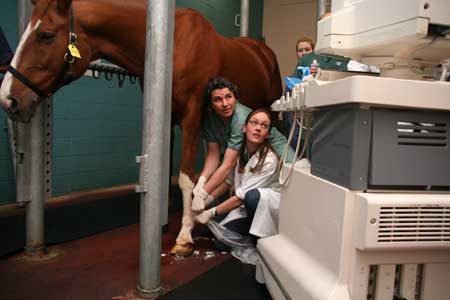ARCHIVE EQUINE NEWS STORIES
| Current news is available at TheHorsePortal.ca, Equine Guelph's online learning platform for practical, quick learning. Given the vast amount of information on horse health and welfare, Equine Guelph has archived its past news articles from 2002-2020. They are listed below, along with a search function available to find specific healthcare topics. | |
Equine specialists, biomedical researchers team up to offer cell therapyJanuary 2008
Lab bench to stallside
Clinicians and researchers at the Ontario Veterinary College have teamed up to offer stem cell therapy to repair injured tendons and ligaments in horses.
The move provides clients with a new treatment option for their animals and will allow OVC researchers to add scientific rigour to the anecdotal evidence that suggests cell-based therapies speed healing of injured or damaged tissues.
“It is cutting-edge technology and we are uniquely equipped to offer all components of the service under one roof — from diagnostics to cell collection and culturing to treatment and follow-up. But there is still a lot to learn,” said Dr. Antonio Cruz, Clinical Studies.
Cruz, an orthopedic surgeon with the OVC Large Animal Clinic, aims to attract the caseload that will contribute clinical data to the knowledge gained from laboratory research being conducted by Drs. Dean Betts and Thomas Koch, Biomedical Sciences. “This is the next progression of the work we’ve already been doing,” said Koch, a veterinarian and PhD candidate whose research to date has focused on the potential for treating damaged cartilage using stem cells taken from the umbilical cord blood of foals. “Obviously, you don’t have access to cord blood for most horses most of the time. But there are other sources.”
Above, Antonio Cruz and Heather Chalmers watch the ultrasound monitor as Cruz injects the stem cell solution into Santiago's injured tendon.
Bone marrow, for instance, as was the case recently with Santiago, a 13-year-old chestnut gelding with a lame front leg and the first to be treated with stem cells at the OVC. Santiago was referred to Guelph in the fall and diagnosed with suspensory desmitis — inflammation of the branch of the suspensory ligament. In early November, Cruz’s team extracted bone marrow aspirate from Santiago’s sternum.
In the lab, Koch and Betts took the aspirate and separated the nucleated cells from red blood cells. They then cultured a fraction of the available cells in plastic flasks containing a special medium (where the stem cells multiply and adhere to the plastic). The cells are then purified and put into other culture flasks. Initially, only about one in 35,000 cells showed stem cell characteristics, said Koch.
Sixteen days after harvesting, the team had 16 million cells that were re-suspended in the original bone marrow supernatant and injected into the swollen fetlock of Santiago’s left front leg.
If Santiago’s condition improves, at this point there is no way of knowing whether the stem cells made the difference, or the growth factors in the supernatant, or simply time and rest or a combination of the above. But hospital cases will add support to the scientific work to be done in the lab and in future randomized clinical trials, said Betts.
“We’re doing this because of promising results elsewhere and the fact that the underlying rationale makes sense, although it’s not evidence-based in a strict scientific sense,” Betts said.
The procedure offers hope to people like Santiago’s owner, Heather Baker-Sullivan of Caledon, Ont.
“He’s my baby,” said Baker-Sullivan, who until the injury rode Santiago, a Trakehner, in local and regional dressage shows and on the Trillium circuit.
“We’ve had him for 10 years. He’s part of the family and I wanted to do the best for him.”
- Barry Gunn
